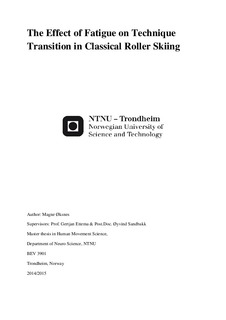| dc.description.abstract | Introduction: Classical cross-country skiing consists of three main sub-techniques; double poling (DP), double poling with kick (DK) and diagonal stride (DIA). The skiers’ transition between these like a "gear system", where the choice of technique is influenced by the physical capabilities of the skier, and other factors like speed, inclination, glide friction and wind resistance. The current study investigated the effect of fatigue on the time and number occurrences of technique transitions and total time used (distribution) of sub-techniques in classical roller skiing at varying speed and inclines.
Methods: Eight male cross-country skiers conducted two test conditions in a randomized, counterbalanced order, in roller skiing on a treadmill using the classical technique. Both test conditions consisted of a pre-test intervention, and a post-test identical to the pre-test. The pre- and post-test consisted of 11 min of constant submaximal work rate with; 3 min on 3% incline to reach aerobic metabolic steady state, followed by an increasing incline to 11% , by 1% each min. The intervention consisted of either a fatigue exercise to total exhaustion or low intensity roller skiing. Physiological and kinematic variables were assessed by the use of open- circuit indirect calorimetry, blood lactate monitoring and Oqus 3D motion capture analysis. Work rate was calculated as the sum of power against gravity and rolling friction.
Results: Oxygen consumption, heart rate and lactate values increased significantly from pre- to post after the fatiguing compared to the low intensity exercise (0.5 vs 1.7 mL kg-1 min-1; 0 vs 12 bpm; 0.3 vs 3.1 mmol/L; all P < 0.05). Technique distribution did not alter significantly after the fatigue exercise, although a tendency towards increased amount of DIA was found (54 ± 4 sec; P = 0.064). The mean transition point from DK to DIA occurred significantly earlier (60 ± 25 sec; P < 0.05), while the total number of transitions did not alter significantly after the fatigue exercise (P > 0.38).
Conclusion: Altogether, the results indicated that the state of fatigue led to utilization of lower gears at lower incline, and thereby an altered technique distribution. However, large individual differences related to technique transitions and choices of technique were observed. | nb_NO |
